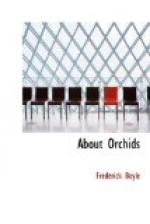Mr. Watson, Assistant Curator at Kew, recalls an amusing instance of the value and the mystery attached to this species so late as 1867. In that year Professor Reichenbach described it for the first time. He tells how a friend lent him the bloom upon a negative promise under five heads—“First, not to show it to any one else; (2) not to speak much about it; (3) not to take a drawing of it; (4) not to have a photograph made; (5) not to look oftener than three times at it.” By-the-bye, Mr. Watson gives the credit of the first discovery to the late Mr. Bowman; but I venture to believe that my account is exact—in reference to the Antioquia variety, at least.
The other form occurs in the famous district of Frontino, about two hundred and fifty miles due north of the first habitat, and shows—savants would add “of course”—a striking difference. In the geographical distinctions of species will be found the key to whole volumes of mystery that perplex us now. I once saw three Odontoglossums ranged side by side, which even an expert would pronounce mere varieties of the same plant if he were not familiar with them—Od. Williamsi, Od. grande, and Od. Schlieperianum. The middle one everybody knows, by sight at least, a big, stark, spread-eagle flower, gamboge yellow mottled with red-brown, vastly effective in the mass, but individually vulgar. On one side was Od. Williamsi, essentially the same in flower and bulb and growth, but smaller; opposite stood Od. Schlieperianum, only to be distinguished as smaller still. But both these latter rank as species. They are separated from the common type, O. grande, by nearly ten degrees of latitude and ten degrees of longitude, nor—we might almost make an affidavit—do any intermediate forms exist in the space between; and those degrees are sub-tropical, by so much more significant than an equal distance in our zone. Instances of the same class and more surprising are found in many genera of orchid.
The Frontino vexillarium grows “cooler,” has a much larger bloom, varies in hue from purest white to deepest red, and flowers in May or June. The most glorious of these things, however, is O. vex. superbum, a plant of the greatest rarity, conspicuous for its blotch of deep purple in the centre of the lip, and its little dot of the same on each wing. Doubtless this is a natural hybrid betwixt the Antioquia form and Odontoglossum Roezlii, which is its neighbour. The chance of finding a bit of superbum in a bundle of the ordinary kind lends peculiar excitement to a sale of these plants. Such luck first occurred to Mr. Bath, in Stevens’ Auction Rooms. He paid half-a-crown for a very weakly fragment, brought it round, flowered it, and received a prize for good gardening in the shape of seventy-two pounds, cheerfully paid by Sir Trevor Lawrence for a plant unique at that time. I am reminded of another little story. Among




